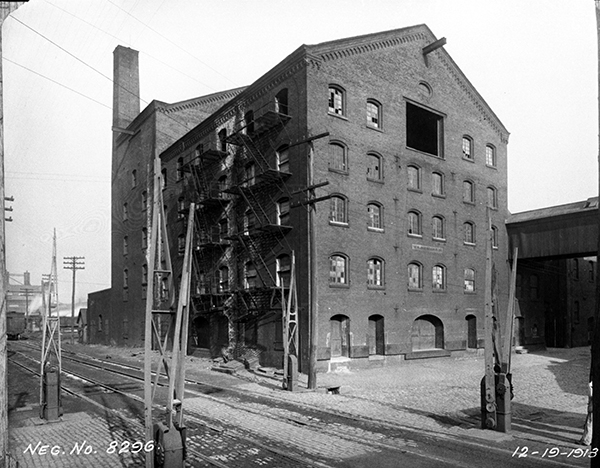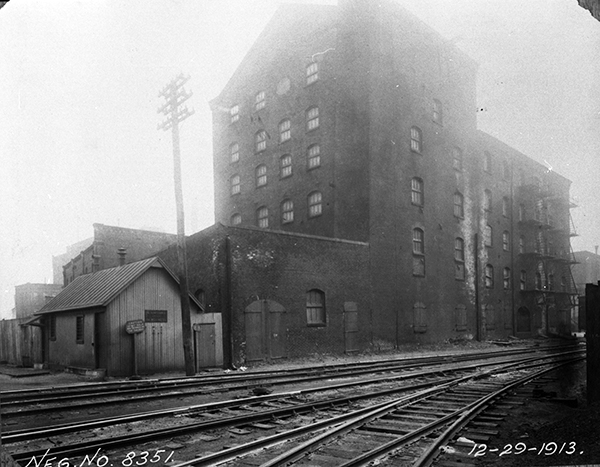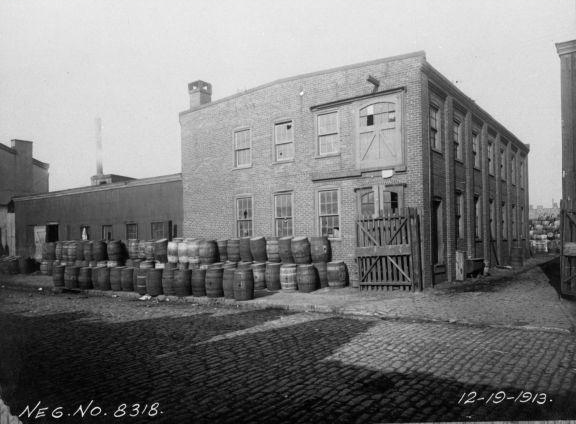More than 2000 workers from the Franklin Refining Company and the William J. McCahan Sugar Refinery went out on strike in late January 1917. Their demands? Ten cents more per hour, double pay for overtime and Sundays off.
Food shortages and steeply rising food prices stretched striking families to the point of starvation. Beef and chicken were now entirely out of reach. Potatoes, cabbage, spinach and parsnips weren’t far behind. Onions recently selling at 2 1/2 cents a pound now cost fourteen cents. The “wives of strikers, who had accumulated small savings before the walkout, declared the food prices were so high that their funds had been quickly exhausted.” What would the strikers do? What could they do?
After a month of picketing, the sugar refinery district on the Delaware waterfront, Reed to Morris Streets, was about to become a battlefield.

Up in New York, the housewives of the Lower East Side, who were not in the midst of a prolonged strike, had declared a food boycott. On Monday and Tuesday February 19th and 20th they vandalized pushcarts and grocery stores and marched in protest to New York City Hall. When the women of South Philadelphia heard that New Yorkers were chanting “Give us bread!” in English and Yiddish, and marching as they cried out “We are starving! Feed our children!” they, too, were ready to consider any and all options. South Philadelphians declared solidarity with the New Yorkers, agreeing to a vendor boycott. They called it a “food strike.”

Many of the wives and female relatives of the refinery strikers were eager for even more of a demonstration. On Wednesday February 21, about two hundred women met a few blocks from the sugar refinery district at Lithuanian Hall, Moyamensing Avenue and Christian Street. Another one hundred gathered at Fourth and Wharton streets. As far as the police were concerned, the purpose of these and other meetings was to plan a march on City Hall, similar to the New York protest. Something happened to the women inside Lithuanian Hall that day. “One after another got up and told of the suffering in her home from lack of food.” Police later claimed they had been stirred into a “frenzy by the preachings of representatives of the Industrial Workers of the World.” Possibly so. They were also moved by the words of South Philadelphia’s homegrown activists. Baby in arms, the 32-year-old Florence Shadle of 110 Wharton Street “insisted that the strike was driving the families of the locked-out men to the verge of starvation.” She urged those gathered “to adopt militant methods to drive out the strike-breakers.”
Shortly after 5pm, about forty of the women left Lithuanian Hall singing and chanting “We want food!” With babies on their hips, or trundling them in carriages or holding their hands, they marched to Front and Reed streets. Some, according to police, came armed with pepper shakers. As they passed the Fire Engine Company #46 at Ostego and Reed streets, protesters traded insults with mounted police. The women showered the policemen and their horses with red pepper.

“Singing labor songs” and “yelling for food,” marchers from both of the meetings converged on the refineries. Police reinforcements arrived, increasing their number to 250. As if on cue, just as the police tried to disperse the protesters, many more “women, men and children appeared suddenly from all sides.”
The crowd of protesters swelled to 2,000.
The “lack of food and money” had transformed the strikers and their supporters “from peaceful workers and citizens into savage fighters,” observed the Inquirer. A truck used to shuttle strike-breakers between the refineries and their homes returned, adding “fuel to the fire of riot.” The protesters were ready to battle “the bluecoats with a strength born of despair.”
“From somewhere came the report of revolver shots. Bullets whizzed by the heads of the policeman as they crouched in the patrol wagons. There came another shower of shot, followed by bricks and other missiles,” debris from a nearby demolition.
“Policeman charged the rioters with drawn revolvers, firing volley after volley into their ranks and getting in return a shower of bullets, bricks and stones.” From windows and housetops during the height of the battle, snipers fired down on the struggling mass in the street, hitting friend and foe alike with bullets and other missiles.”
“Many of the women, children, and men were badly bruised by the clubs of the police” who showed” no mercy and struck at all who came within their reach.”
The officers attempted “to round the rioters into a huge circle.” Then “they fired their revolvers straight at the mob which, in its collective fury, charged the police.”
The battle lasted nearly two hours.

“One man was killed, four others, including two policemen, probably fatally injured, 10 more seriously hurt and scores bruised and cut last evening,” reported the Inquirer the next morning. It was “the most desperate and bloody riot which has occurred in Philadelphia for years.”
The reported fatality, Martin Petkewicz, a 30-year old from the 100 block of Tasker Street, had recently joined the Industrial Workers of the World. He was reportedly “shot through the heart and killed as he stooped over to pick up a brick.” After the fighting had subsided, police found Petkewicz’s body “at the intersection of Front and Reed streets, bruised and battered by the hundreds of feet which had trampled on it while the fight was on.” Days later, several thousand fellow strikers followed his funeral cortege as it made its way through blocks of rowhouses to Saint Casmir’s on Wharton Street.
“In a hastily organized meeting” called immediately after the riot, “several hundred women assembled in a synagogue at Sixth and Sigel streets.” Pauline Goldberg, of 449 Durfor Street, urged everyone to focus on the issue they all shared: the exorbitant price of food.
“Our children and our husbands are not getting enough to eat,” she said. “If we have potatoes and onions and a little barley, we can do without meat forever, but with potatoes at seven cents a pound where they used to be two and three cents and onions at sixteen cents when they used to be five and six cents, we cannot live.”
“Drastic measures would have to be taken to bring down the price of the two staple articles of their diet,” Goldberg urged.” It’s up to us to do something.”
But what? What would the women of South Philadelphia do?
[Sources: “Sugar Prices Soar as Strike Goes On,” The Philadelphia Inquirer, February 13, 1917; “Vegetables Have Soared to Unprecedented Mark,” Evening Public Ledger, February 21, 1917; “Food Riots Sweep Through New York, Ghetto to Harlem,” The Philadelphia Inquirer, February 21, 1917; “1 Killed, 14 Hurt, When Hungry Mob Fights Policemen – Wives of Sugar Refinery Strikers Lead Attack; 4 More May Die,” The Philadelphia Inquirer, February 22, 1917; “Police Slay Mob Chief in Sugar Strike – Thirty Hurt When Woman with Baby Leads Refinery Men,” Evening Public Ledger, February 22, 1917; “Attacks on Police Renewed; Striker Shot During Clash,” The Philadelphia Inquirer, February 23, 1917; “War prosperity and hunger: The New York food riots of 1917,” William Frieburger, Labor History, March 1984, Vol. 25, No. 2.]
